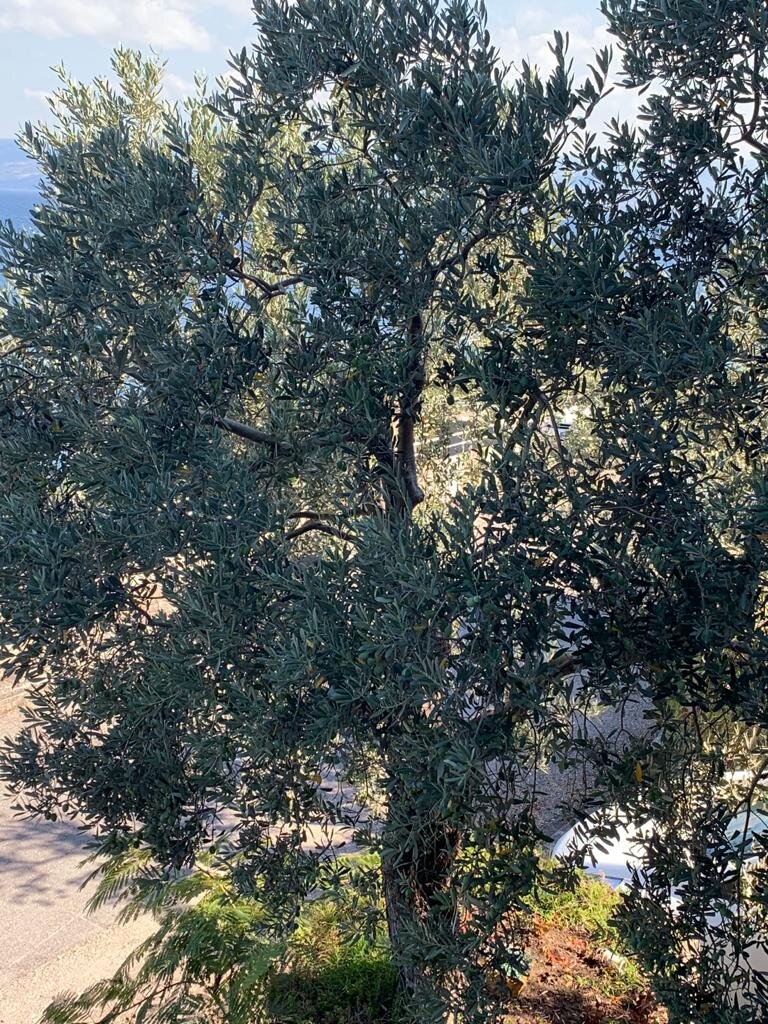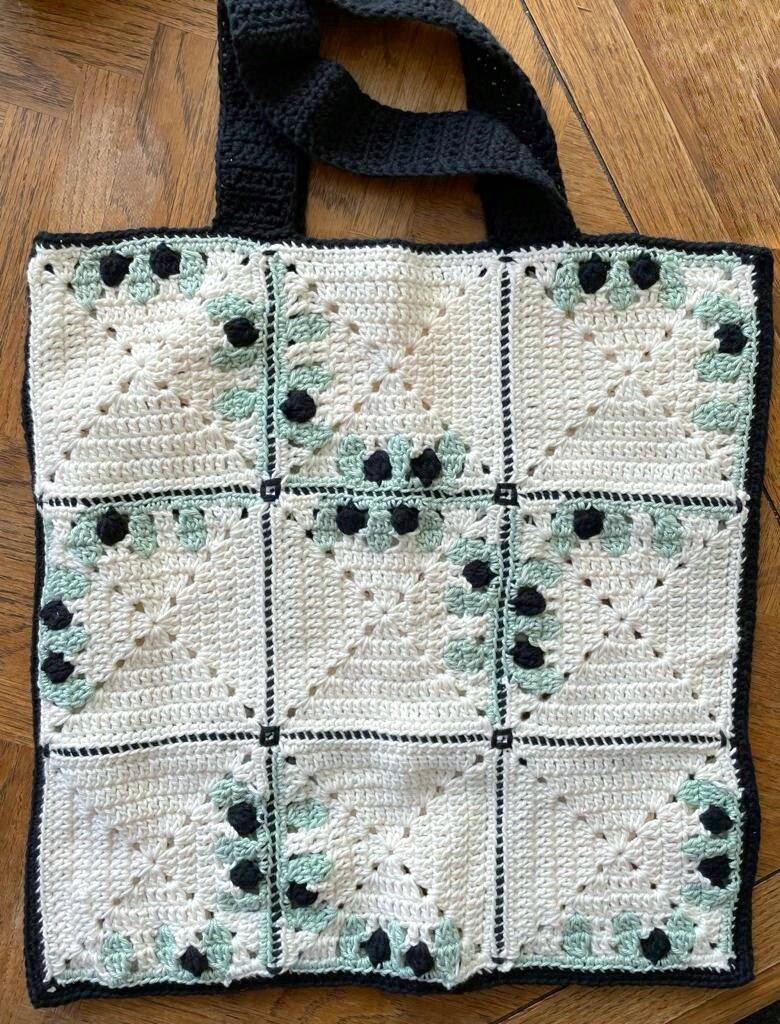The Olive Tote: Tree Collection
This is the blog post and inspiration for the second pattern of the year long Tree Collection by The Queen Stitch and LoveCrafts. Read More about the Tree Collection here.
Aysegul with her tote
Olive Trees at the Sea of Marmara
The Olive Tote
Aysegul [Eye-shah-GOOL]
Ayse and I met because of fate. We were in the same cohort of new joiners at a large tech company in Dublin, and by accident, we sat next to each other on our first day. Among those first few surface-level tentative chats, we found we were very different: I was from the US, and she, Turkey; I was hired for data analytics and architecture, she, for counter terrorism expertise; she’s Gen Z, I’m a millennial… I could go on. We may be different people, but Ayse has a ton of qualities I really admire and wish I had at myself. She is tenacious, ambitious and innovative. She’s laser focused and spends most of her free time reading up on the latest world news, and being mentored in new skills that can be applied to her work (though one time she did let me teach her to knit - thank you very much).
When I first introduced Aysegul to my sister-in-law, she was asked what she does for work and answered, “It has to do with terrorism”, to which my sister-in-law responded “Oh! What kind of tourism?”. Ayse said it happens all the time. She is quite petite at 5 foot 0 inches, friendly, with a pretty face, so if you lay heavily onto stereotypes, it could seem more likely for her to work in tourism rather than terrorism just by looking at her. These same stereotypes follow her around at work, but they’re no match for her energy and focus - it’s been really inspiring for me to watch her not only continuously succeed, but thrive in what is definitely considered a challenging environment from multiple perspectives.
Bursa, Turkey
In her own words, “The best part of growing up in Bursa is that it has everything you want. It’s between a mountain [Mount Uludağ] - with ski resorts during the winter, and the water [Sea of Marmara] - which in summer we can have an awesome beach day and chill...
“Bursa is the fourth biggest city in Turkey with something like 2-2.5 mill people. It’s a pretty homogenous city, most families have been there for a long time. It was the first capital of the Ottoman empire, (before we conquered Istanbul - then known as Constantinople). Three Emperors are still buried in Bursa.
“Also it’s really old, the ancient Greeks were in Bursa, and the Romans before the Ottomans. We have a famous mausoleum that is really old called The Green Tomb and it brings many visitors and tourists every year. It was built in 1421 by Mehmet the Ist.
“When I was growing up we had one shopping mall which was pink, and everyone would go. I still remember when the Burger King opened and everyone had their birthdays there. It was a big deal to go. Then when I left and went to Istanbul - which has a million more malls, in that time Bursa got many more malls as well, and when I moved back the pink mall was being torn down! And now there’s Burger Kings everyone and no one cares.
“Now that the city is becoming so commercialized, you’re losing a little bit of the close family feeling, and many more people are moving in. Food is very different in Bursa from the rest of the country, we’re known for our candied walnuts, lighter foods, peaches. Iskender Doner was invented in Bursa. We’re now having a lot of the heavier kebab stuff, and becoming more of a stopping point on the way to Istanbul rather than a destination in itself.
“That’s sort of the fate of Bursa. Many people who grow up there end up moving to Istanbul for awhile. They’re like sister cities where Istanbul is the cool sister, that everyone wants to hang out with, but then they come back and realize... Because it’s safe and nice, and relaxed.
“We clash a lot with Istanbul in terms of conservatism, and the city is only getting more conservative with the new people moving in. I am really proud I am from there and grew up there, so I don’t want it to seem like I don’t like it. My whole family is from there, my grandfather’s uncle is a famous painter with a museum in Bursa, and now his great niece is also an amazing painter and has all her own galleries in Bursa too.
“I always wanted more though, I was ready to leave, like a lot of my generation. I will always go back to our summer house but.... I want to keep traveling.”
Ayse’s summer view
Baby Ayse
Olive tree in her yard
Why the Olive
“My family has a second house in Bursa, but in a region called Tirilye, next to the sea. This area was inhabited by the Byzantine Greek people, and a lot of that original architecture and even some of their descendants are still there! It’s covered in olive trees, and pastel covered houses.”
“In our garden there we have olive trees. The olives from our trees are much smaller than what you’d get in the stores. We have 3 floors, and on the second floor we have a veranda that the branches reach right down into and we can just pull them off from there.”
“[...]Olives and olive oil are really important to our culture and most Mediterranean cultures. You get olives on the table every meal. In Turkey, almost every meal has 2 versions: a version with olive oil and without. The hot ones are usually without and the cold ones are usually with.”
“Olive tree is wealth. If you have a tree on your property you are considered wealthy - regardless of how much money you make. It’s this luxurious treat of nature. Running around when I was younger I felt like a goddess. You know the Greek goddess myths and its importance in those myths? That’s what I felt like.”
Olive leaves
Ayse with the Olive Tote
Olive tree bark
Facts + Folklore about Tirilye olive
The region where Aysegul’s family has their house next to the lake, actually has their own species of olive tree - the Tirilye olive. A small to medium black olive with a high oil content, often served with breakfast.
Olive trees (of a type) had origins 20-40 million years ago, while people starting cultivating the trees as many as 7,000 years ago. Olive trees are squat and rarely exceed 15 meters, but can easily live for 1,000 years. Olive leaves - which are a grayish green - are small, oblong, and not serrated - under a microscope you can see that the leaves are actually made up of tiny circular scales that reduce evaporation in high heat or wind. Feathery white flowers become ‘stone’ or ‘pit’ fruit later on. The bark is usually cracked, and pinkish-gray to pinkish-brown.
The Olive tree in Greek Mythology was called “the greatest gift to mankind” as it could be used for it’s wood, leaves, fruit and oil - covering just about every aspect of life. The Greek mythology around Olives is perhaps the most well-known to this day, however, perhaps even older are the myths in the Hebrew faith.
In the Hebrew Bible, or Christian Old Testament, it is mentioned both in Genesis 8:11, and Deuteronomy 8:8: as being both a symbol of peace and finale - the olive branch brought back by the dove to Noah’s ship to show the flood was over; and a symbol of bounty - one of the 7 species listed as important products available in Israel.
Olives are mentioned in both the New Testament and the Quran as well. In the New Testament, as well as the oil being used for anointing, The Olive Tree allegory in Romans is a well known comparison to the scattering and regrouping peoples of Israel. In the Quran, olives are praised as a ‘precious fruit’ and used in healing and Prophetic medicine - to be massaged with olive oil is is supposed to provide blessings.
As for the Ancient Greeks…. The real question is what didn’t they use the olive trees for. Olive oil was used to anoint both kings, and great athletes. Burnt as the sacred flame is the Olympics, and the victors crowned with its leaves.
Athena, the goddess of wisdom was quite partial to olives. She won the patronage of Athens and the Attica peninsula from Poseidon with a gift of an olive, and people from Athens have insisted since ancient times that the original olive tree came from there.
References:
Boskou, D., ed. (1996). Olive Oil. Chemistry and Technology. AOCS Press.
Drori, Jonathan Around the World in 80 Trees “Olive” (2018) p.78
Therios, Ioannis Nikolaos (2009). Olives: Volume 18 of Crop Production Science in Horticulture (History of Olive Growing, page 1).
Pattern proceeds
25% of the proceeds from this pattern will go to the Turkish Foundation for Preventing Soil Erosion (TEMA). The organization has planted millions of saplings across Turkey and supports re-forestation along with combating erosion and desertification across the country. Click the link to learn more or donate separately https://www.tema.org.tr/
The Pattern
This chic tote pattern utilizing the classic granny square with a new twist - Tirilye olives! The tri-color pattern features olive branches and bobble olives to create a big square tote design. Perfect for spring and summer - or anytime! This crochet pattern is beginner-intermediate, and uses the cheap and fabulous Cotton DK from Paintbox yarns.
















